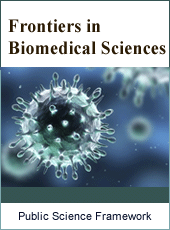Frontiers in Biomedical Sciences
Articles Information
Frontiers in Biomedical Sciences, Vol.1, No.1, Sep. 2016, Pub. Date: Aug. 16, 2016
Delayed Development of Symptomatic Nontraumatic Chronic Subdural Hematoma Following Surgical Excision and Radiotherapy for Intracranial Glioma Causing Cognitive Impairment: Review
Pages: 21-25 Views: 3771 Downloads: 2482
[01]
Guru Dutta Satyarthee, Department of Neurosurgery, Gamma Knife, AIIMS, New Delhi, India.
[02]
Luis Rafael Moscote Salazar, Neurosurgeon-Critical Care, RED LATINO Latin American Trauma & Intensive Neuro-Care Organization, Bogota, Colombia.
Neurological worsening in case of glioma during follow-up period, following gross total surgical excision and subsequently received radiotherapy, common causes are recurrence of lesion at the operative site, radiation necrosis, radiation induced intracranial tumor recurrence at distant site, seizure, vasculitis, hydrocephalus, meningitis, however, rarely chronic subdural haematoma can also be responsible. Authors report a 39-year -old female with grade II astrocytoma in the right temporal lobe, underwent craniotomy and gross total excision of glioma, received radiotherapy and a course of chemotherapy. She presented with recurrence of symptoms, 18 months after the adjuvant therapy. Cranial computed tomography revealed chronic subdural hematoma (CSDH) and underwent burr-hole craniostomy for evacuation of chronic subdural hematoma. After surgical evacuation of chronic subdural haematoma, headache along with fresh neurological deficit improved completely. To the best of knowledge of authors, current study is the first report in the western literature. Pertinent literature and management is briefly discussed. Authors recommends, possibility of chronic subdural hematoma development in the follow-up period must also be kept as one of differential diagnosis for neurological worsening of surgically resected glioma followed by radiotherapy.
Corpus Callosal Glioma, Radiotherapy, Chronic Subdural Hematoma
[01]
Scott M. Spontaneous intracerebral hematomas caused by cerebral neoplasms. J Neurosurg. 1975; 42:338-342.
[02]
Missori P, Maraglino C, Tarantino R, Salvati M, Calderaro G, Santoro A, Delfini R. Chronic subdural haematomas in patients under 50. Clinical Neurology and Neurosurgery. 2000; 102:199-202.
[03]
Salcman M. Intracranial hemorrhage caused by brain tumour. In: Kangman HH. (Ed) Intracerebral hematomas, New York, Raven Press. 1992, pp 95-106.
[04]
Kondziolka D, Bernstein M, Resch L et al. Significance of hemorrhage into brain tumours: Clinicopathological study. J Neurosurg. 1987; 67; 852-857.
[05]
Wakai S, Yamakowa K, Monaka et al. Spontaneous intracranial hemorrhage caused by brain tumours, its incidence and clinical significance. Neurosurgery 1982; 10; 437-444.
[06]
Kohli CM, Crouch RL. Meningioma with intracerebral hematoma. Neurosurgery. 1984; 15:237-240.
[07]
Liwnicz BH, Wusz, Tew JM. The relationship between the capillary structure and haemorrhage in gliomas. J Neurosurg. 1987; 66:536-541.
[08]
Glands B, Abott KH. Subarachnoid hemorrhage consequent to intracranial tumour. Review of the literature and report of seven cases. Am Med Assoc Arch Neurol Pshychia. 1955; 73:369-379.
[09]
Cowel Rl, Siqudra EB, George E, Angiographic demonstration of glioma involving the wall of anterior cerebral artery. Report of a case Radiol 1970; 97:577-578.
[10]
Prabhu VC, Bailes JE. Chronic subdural hematoma complicating arachnoid cyst secondary to soccer –related head injury: Case report. Neurosurgery. 2002; 50:195-198.
[11]
Ranganadham P, Mohandas S, Purohit AK, Ratnakr KS, Dinkar I. Subdural haematoma associated with fibroblastic meningioma: Case report and review of literature Neurol India. 2001; 49:182-184.
[12]
Tsai FG, Huprich JE, Segall HD, Teal SJ. The contrast-enhanced CT scan in the diagnosis of isodense subdural hematoma. J Neurosurg. 1979; 50:64-69.
[13]
Mashiyama S, Fukawa O, Metani S, Asano S, Sai T. Chronic subdural hematoma associated with malignancy: report of three cases. No Shinkei Geka. 2000; 28:73-178.
[14]
Satyarthee GD, Mahapatra AK. Giant pediatric glioblastoma multiforme causing primary calvarial erosion and sutural diastasis presenting with enlarge head in 13-year old boy: Rare entity. J Ped Neurosciences. 2015; 10:290-293.
[15]
Raheja A, Satyarthee GD, Mahapatra AK Chronic subdural hematoma development in accelerated phase of chronic myeloid leukemia presenting with seizure and rapid progression course with fatal outcome. Romanían Neurosurgery. 2015; 29(2):199-202.
[16]
Satyarthee GD. Chronic Subdural haematoma development following transsphenoidal surgery for Pituitary Adenoma Apoplexy: An incidental or Real Association. American Journal Clinic Neurol Neurosurg. 2015; 1 (3):150-153.
[17]
Borker SA, Satyarthee GD, Mahapatra AK, “Armoured brain” syndrome: chronic calcified subdural hematoma. Pan Arab J Neurosurg 2013:17; 23-27.
[18]
Garg K, Singh PK, Chandra PS, Singh MM, Satyarthee GD, Sharma BS. Bilateral armoured syndrome due to calcified subdural hematoma following VP shunt surgery. Neurol India. 2013; 63:548-550.
[19]
Takahashi Y, Ohkura A, Sugita Y, Sugita S, Miyagi J, Shigemori M. Postoperative chronic subdural hematoma following craniotomy--four case reports. Neurol Med Chir (Tokyo). 1995; 35(2):78-81.

ISSN Print: Pending
ISSN Online: Pending
Current Issue:
Vol. 2, Issue 4, July Submit a Manuscript Join Editorial Board Join Reviewer Team
ISSN Online: Pending
Current Issue:
Vol. 2, Issue 4, July Submit a Manuscript Join Editorial Board Join Reviewer Team
| About This Journal |
| All Issues |
| Open Access |
| Indexing |
| Payment Information |
| Author Guidelines |
| Review Process |
| Publication Ethics |
| Editorial Board |
| Peer Reviewers |


